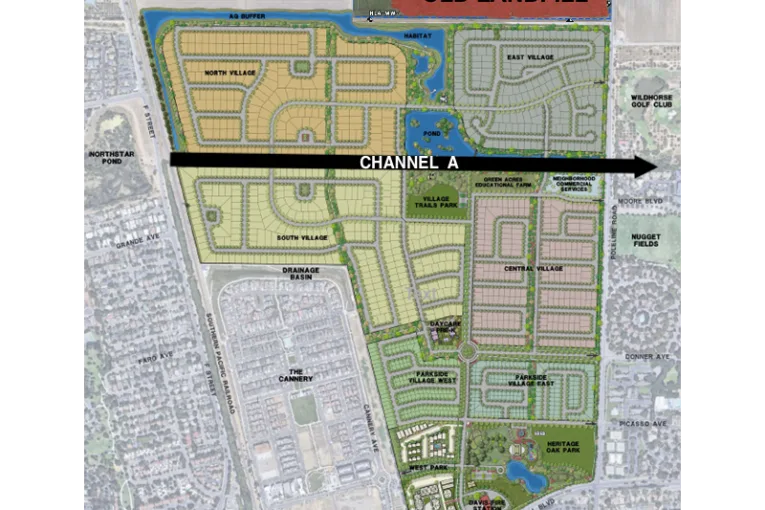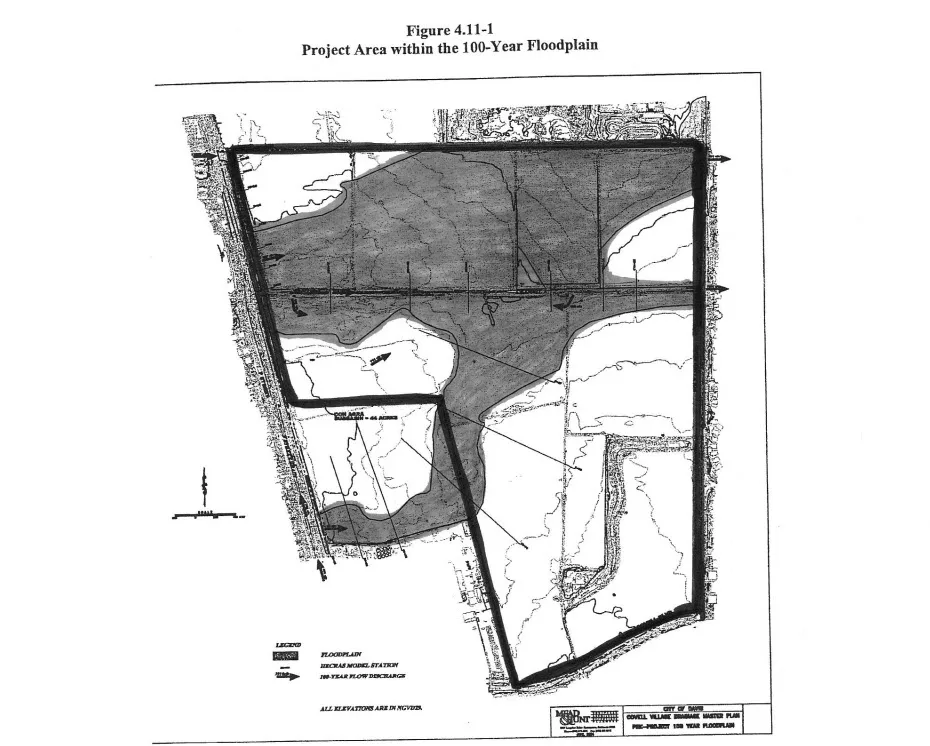
The Draft Environmental Impact Report (DEIR) has been released for comments on Village Farms, on a parcel outside city limits, which is the largest project ever proposed for Davis with 1,800 units on almost 500 acres. The DEIR was rushed and is inadequate since it’s missing important details and makes unwarranted assumptions and conclusions.
The project has a multitude of problems primarily because it is a seriously handicapped land parcel. The site’s serious issues include a 200-acre flood plain, being located adjacent to the unlined Old City Landfill and Sewage Treatment Plant with a long history of leakage into the ground water of toxics and other chemical contaminants (now including PFAS, “forever chemicals”), enormous traffic issues already at Covell Blvd. and Pole Line Rd., access issues because it cannot be accessed from F St. due to the railroad tracks and there’s questionable feasibility of a Pole Line undercrossing, massive impacts on habitat, and enormous costs of the infrastructure and services needed.
History
Historically, the site was first proposed for the Crossroads project in 1992, but after those developers realized that the project site was plagued with so many problems, particularly the enormous flood plain, toxics, traffic, access and infrastructure needs, that they abandoned the project and put the land up for auction. John Whitcombe, of Tandem Properties, was the primary investor who purchased the 386-acre parcel for only $3.2 million, which was a massive financial loss by the Crossroads developers.
Whitcombe proposed two earlier versions: Covell Center and later, after Measure J was approved by Davis voters his Covell Village project was on the 2005 ballot. It was rejected by voters due to all the problems it would bring including the massive impacts and costs. Now the 1,800 housing unit Village Farms is the latest iteration, but it has all of the same issues and even more impacts and costs.
The DEIR has been rushed to accommodate the developers’ wishes to rush to a Measure J/R/D vote quickly, and as a result, it is seriously lacking in details and dismisses the serious impacts and consequences the project would bring if approved.
It is disappointing that the Proposed Project assumed that the vernal pools (protected by Federal law) could be paved over. The developer proposed paving over the vernal pools in previous versions but environmentalists protested because sampling was done in dry season when the vernal pools were absent. Vernal pools reemerge in wet seasons when seeds, including rare native plants and eggs of endangered Vernal Pool Tadpole Shrimp hatch. Public pressure motivated proper sampling this time, and these rare and endangered species were revealed confirming the vernal pools. The developer then had to add the Biological Resources Preservation Alternative (BRPA) version. With the exception of the vernal pools being excluded from development in the BRPA, both the Proposed Project and the BRPA version both have 1,800 housing units, and they have the other same problems and impacts. Fortunately, the vernal pools survived discing, however the burrowing owl habitat did not in 2005.
Village Farms has too many problems, impacts and costs:
Traffic – Traffic impacts at Covell Blvd. and Pole Line Rd. are currently incredibly impacted, but shoe-horning in 1,800 would result in gridlock with more greenhouse gases and air quality deterioration. The DEIR claims that traffic impacts would be lessened with a high density of housing making the false assumption that residents will use much more public transit. This is a fantasy since Davis has a minimal, inadequate, and inconvenient public transit designed primarily for UCD needs, not community needs. Furthermore, the City has no plans to significantly expand its public transit. Creating a high-density of housing without a robust transit system would only exacerbate environment impacts by increasing traffic.

200-acre flood plain – The enormous Village Farms flood plain is a FEMA Zone A Special Flood Hazard Area. Building hundreds of housing units on roughly 200 acres of flood plain is a huge problem, since a fundamental planning principal is that you do not build on enormous flood plains like this. This is not only because of climate change issues, but because of State legislation where California will no longer financially bail out cities foolish enough to build on flood plains like this when flooding disaster happens. That is more likely now than ever, due to climate change.
Toxics from the adjacent Old City Landfill and Sewage Treatment Plant – The unlined Old City Landfill and Sewage Treatment Plant adjacent (north) to Village Farms has had a long history of toxics and other chemical contaminants leaking into the groundwater. Landfills are supposed to have large “exclusionary zones” or at least a 1,000-foot buffer zone for health and safety reasons. Village Farms should not be building so close to the Old City Landfill and Sewage Treatment Plant. The toxics leaking include PFAS “forever chemicals” and manganese exceeding maximum concentration levels (MCL) recently reported from monitoring wells. How many people will want to buy a home of at least $700,000 to over $1 million sitting on land with contaminated groundwater with chemicals in high levels that cause cancer?
Soil toxics, UATA “dig-pit” and Park site -The 118-acre Urban Ag Transition Area (UATA) is adjacent (west) to the Old City Landfill and the soil has arsenic levels that are 50X -70X what residential soil should have. The developers want use this soil as a “dig-pit” for filling the enormous 200-acre flood plain. The Heritage Oak Park site has toxics in the soil with Toxaphene as high as 1,200,000 mg/kg and Lead 93 mg/kg, both exceeding maximum DTSC levels.
Re-routing Channel A – Trying to move and re-route the massive amount of runoff water currently being soaked up by over 400-acres of farmland could result in disastrous flooding. This includes the possibility of contaminated groundwater mixing with channel runoff, which then flows east through Wildhorse and potentially polluting the wetlands – a catastrophic scenario. Would expensive flood insurance be required of north Davis residents due to Village Farms?
Habitat impacts – The project would tear out 952 number of trees to expand and reroute Channel A which will have significant impacts on the habitat, particularly rare and endangered species, and raises major concerns about potential flooding.
Access issues and infrastructure costs – Serious access issues remain including with no bicycle/pedestrian access via F St. because of the railroad tracks. The DEIR refers to the questionable “feasibility” of a Pole Line Rd. undercrossing due to existing infrastructure issues, so there may not be a Pole Line bicycle/pedestrian undercrossing crossing either. Even if feasible, the developer has indicated that he would not cover the entire cost, although his project is driving the need for it. Further, this 1,800-unit project would use an enormous amount of water and wastewater treatment capacity and City services. These infrastructure costs would fall on Davis residents.
Additional Fire Station is not needed – The additional fire station being proposed is not needed because roughly 90% of the fire department calls are medical, not fire related issues. An Emergency Medical Service (EMS) would make much more sense and cost far less. Building a new Fire Station would cost at least $14 million to build, and many millions of dollars more for additional staffing (including fire fighters), equipment, and operational costs long-term. Also, how could a fire truck possibly get onto Covell Blvd. (especially going east) when the traffic is backed up most of the time?
Unaffordable housing – The average home would be at least $700,000 – $800,00 per a project representative, but the high-end homes would be far more expensive.
EIR Inadequacy – The DEIR is seriously flawed for many reasons, including lacking important information like the undercrossing uncertainty, and dismissive conclusions. It also fails to comply with CEQA requirements for EIR’s to include alternatives that create less impacts. Yet, all of the alternatives are 1,800 housing units or more, with the exception of the “No project” and the 1,395-housing unit original proposal with the same layout as the 1,800-housing unit Proposed Project version.
The City Council could have included a citizen-based recommendation for a down-sized “build below the channel” alternative, but they completely ignored it. The DEIR should have included analyzing building only below Channel A, preserving the vernal pools and reducing the housing units to a reasonable number. This design avoids the bulk of the flood plain, and moves housing much further away from the Old City Landfill and Sewage Treatment Plant toxics leakage.
In summary, it is important to submit comments and concerns about the Village Farms project and its DEIR before the February 25, 2025 5 p.m. deadline to City Staff member Dara Dungworth at ddungworth@cityofdavis.org In short, the 1,800 units 497-acre Village Farms project is too big, has far too many impacts and costs, has predominately unaffordable housing, and is simply bad planning. Furthermore, this project would present potential City liability issues regarding toxics, flooding and public safety issues.
Residents concerned about Village Farms project, can contact our group Citizens for Responsible Planning group at citizens@dcn.org.
Eileen Samitz is a former Davis Planning Commissioner and served on the City of Davis 2001 General Plan Update land use committee and the subsequent Housing Element Update Committee.
I suspect that Measure J proposals are not “won” or “lost” based upon EIRs.
In this particular case, I suspect that the absence of an underground (or above-ground) crossing for bicyclists and pedestrians is reason-enough for voters to reject it.
Eileen uses the wrong metric on the need for a new fire station. It isn’t the number and type of calls that is the standard. The standard is based on response time.
I thought we all agreed that we need more housing.
Sharla,
The problem is this project would bring massive impacts and costs, including health and safety issues, plus the housing would not be affordable to average income residents, particularly young families.
Ron G.,
90% medical calls is the wrong metric? Sorry, but I think most people, especially those who have had medical emergencies would likely not agree with you. A firetruck trying to access Covell Blvd. particularly if cars from 1,800 more housing units were contributing to the current traffic backed-up on Covell Blvd. (and Pole Line Rd. ), would leave a fire truck stuck re waiting to trying to get onto Covell Blvd. for far more than a few minutes. An emergency medical service (EMS) service makes far more sense, and can be located almost anywhere in East Davis, and would not have the enormous costs of a new fire station (at least $14 million) plus the many $ millions to build and operate, staff, and equip long-term.